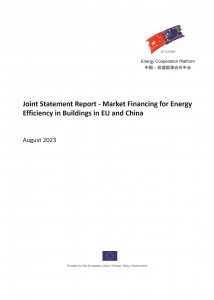
In both the EU and China, buildings account for a significant proportion of overall energy consumption and emissions in their respective economies.
In Europe, buildings are responsible for about 40% of total energy consumption. China’s building sector accounts for more life-cycle energy consumption than any other sector and the vast majority of buildings in both regions have not yet been renovated to reduce emissions, leaving potential for significant energy efficiency improvements.
This study focuses on the role the market plays in driving further improvements and aims to provide a deeper understanding of the role of market instruments in building sector segmentation (residential, commercial, existing, new build).
Both the EU and China realise that they need to improve the energy performance of their building stock, the task is complex, requiring many separate elements to be addressed.
This report
- Outlined the current approaches to building energy efficiency in EU and China
- Discussed various options available in both regions that can help finance building energy efficiency
- Identified the main bottlenecks and barriers hampering financing energy efficiency in building
- Highlighted important lessons learned from both the EU and China that can be shared to inform further improvements as both regions race to cut emissions.,/li>
Notable recommendations to policymakers and the financial community include:
- While state finance and policy support are crucial, it is also vital for a wide range of financial instruments to be available in order to mobilise the market and ensure adequate levels of investment to deliver the necessary efficiency savings.
- Ensure that high energy-performing new and existing buildings are monitored for effectiveness and that technical standards remain under regular review.
- Incorporate the building sector into the ETS market so that carbon assets can be traded for financing; create carbon financial products to secure long-term bank loans.
Further Cooperation Potential
- The EU taxonomy regulation and China’s updated taxonomy were both released in the same week in 2020. There is scope for further harmonisation to facilitate the flow of investments between the two regions.
- Both regions have separately developed an array of financial instruments to meet the needs of different consumer categories. Innovative approaches such as green mortgages and one-stop shops could help boost public awareness and increase the impact of energy efficiency measures.
Download: PDF (722 kb)